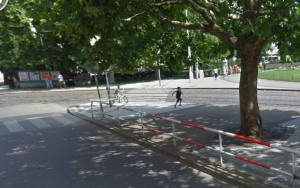
Here’s the picture and here is the permalink to the picture if you want to see a larger image.
——————————————————-
This post will center focus on Walter Benjamin’s idea of the aura with relation to the image attached to this post. Benjamin’s idea of the aura is “the unique phenomenon of a distance, however close it may be” (4). He further goes on to say that this aura decays as it progresses. This is what I am aiming to represent in my image. Looking at it from left to right or top to bottom, one can see on the left the green tree with life; however, as it moves towards the right, this decay of death is seen through the tree on the left. This tree looks rather dead. This is also depicted in the image from top to bottom. The blue symbolizes life and moving down it gets cloudier until the plants are shown rather dead as well. The idea that auras degenerate over time is stated by Benjamin as well by stating that the masses remove the uniqueness of an item by having it constantly reproduced (4). This means that as more and more of the same reproductions come into availability, the item loses it’s value. I once read a book called The Cave by Jose Saramago who was a potter. He usually sells his items to a mall which would then sell his wares to buyers; however, this one day, his work is refused due to the reason that the bowls he makes out of ceramic have no more value or use because of the new plastic bowls that can be made and bought for cheaper for more profit.


